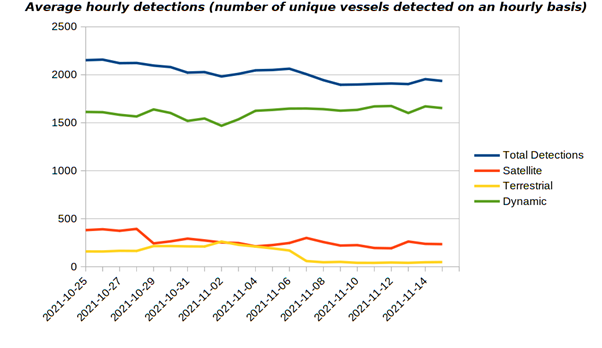On 1 November 2021, China started the implementation of its new privacy laws which has had an adverse impact on terrestrial AIS networks. Specifically, several Chinese terrestrial AIS network operators have stopped transmitting data until they have clarity around the regulations impact of the new privacy laws (they potentially face penalties by distributing the data).
As a data platform that relies heavily on AIS data, Oceanbolt has followed the situation closely and has prepared for the worst case scenario – that we might not see these Chinese terrestrial networks coming back into operation for any foreseeable future. AIS data powers several of Oceanbolt’s algorithms, so we did a detailed analysis of the impact of our different AIS sources. This analysis is summarized in the figure below.

Analysis of AIS positions received on an hourly resolution for the past three weeks for vessels > 20k DWT in Oceanbolt’s China zones.
Overall, we have seen a small drop overall from ~2,200 vessels to ~2,000 vessels in the average number of unique vessels detected on an hourly basis in our Chinese zones. As is evident from the figure above, we have seen a big drop off in the number of terrestrial detections of vessels in China. So we can confirm that the amount of terrestrial messages in China is significantly below normal values. However, we have not seen a significant drop in the detection rates of vessels overall. This is helped by the fact that we have fully integrated dynamic AIS sources into our systems, and this dataset provides a great coverage in high traffic areas such as South China Sea / Bohai Bay.
While dynamic AIS is helpful, we also have a comprehensive set of algorithms and business rules in place to ensure that our algorithms are resilient to temporary drops and lack of coverage, which supports data series such as our congestion and zone count charts. As an example, Oceanbolt’s congestion algorithm is, on a high level, based on the number of laden/ballasters sitting idle inside anchorage zones, however, we have enriched it with our own logic to account for missing data and to get a more “correct” congestion number.
Want to learn more about Oceanbolt? Request a demo or sign up for a free, 3-week non-obligatory trial of the Oceanbolt Intelligence Platform.



 Dr Alex Adamou
Dr Alex Adamou
 Rebecca Galanopoulos Jones
Rebecca Galanopoulos Jones